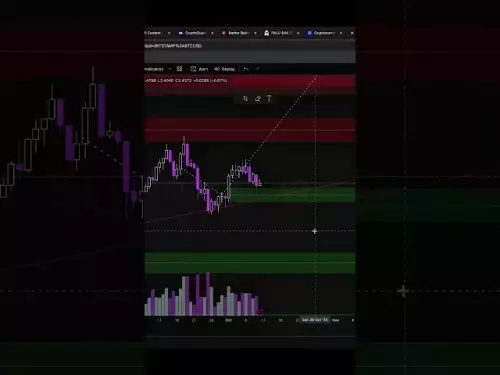-
 bitcoin
bitcoin $110311.910091 USD
1.97% -
 ethereum
ethereum $3964.172463 USD
0.34% -
 tether
tether $1.000288 USD
-0.05% -
 bnb
bnb $1098.563056 USD
-0.37% -
 xrp
xrp $2.479902 USD
4.31% -
 solana
solana $188.301025 USD
1.38% -
 usd-coin
usd-coin $0.999961 USD
0.01% -
 tron
tron $0.322477 USD
0.49% -
 dogecoin
dogecoin $0.199450 USD
2.51% -
 cardano
cardano $0.662393 USD
2.33% -
 hyperliquid
hyperliquid $37.947663 USD
1.71% -
 chainlink
chainlink $18.819081 USD
9.53% -
 ethena-usde
ethena-usde $0.999345 USD
-0.04% -
 stellar
stellar $0.323467 USD
2.06% -
 bitcoin-cash
bitcoin-cash $479.282126 USD
1.50%
Forecasting the prospects of short-term currency speculation skills
By understanding short-term currency speculation concepts, identifying trading opportunities through technical analysis, and employing risk management strategies, traders can potentially enhance their forecasting accuracy for profitable outcomes in the cryptocurrency market.
Jan 08, 2025 at 08:18 pm

- Understanding the concept of short-term currency speculation
- Identifying potential opportunities in the cryptocurrency market
- Developing a trading strategy based on technical analysis
- Managing risk through stop-loss orders and position sizing
- Staying informed about market news and trends
Short-term currency speculation is a strategy that involves buying and selling cryptocurrencies within a short period, typically ranging from minutes to days. The goal is to profit from small price fluctuations by taking advantage of market inefficiencies and volatility. Speculators use technical analysis to identify potential trading opportunities and develop strategies based on price patterns and indicators.
2. Identifying Potential OpportunitiesTo identify potential trading opportunities, speculators focus on various factors such as:
- Volume: High trading volume indicates market interest and potential volatility.
- Volatility: Cryptocurrencies with high volatility offer greater potential for quick profits but also increased risk.
- Market sentiment: Analyzing social media, news, and market commentary can provide insights into investor confidence and market direction.
Technical analysis involves studying historical price data to identify patterns and trends that can help predict future price movements. Common technical indicators include:
- Moving averages: Trailing averages that smooth out price data and identify potential support and resistance levels.
- Relative Strength Index (RSI): Measures the strength of a trend and indicates potential overbought or oversold conditions.
- Stochastic oscillator: Shows the speed and momentum of price changes, helping identify potential trend reversals.
Managing risk is crucial in short-term currency speculation.
- Stop-loss orders: Limit potential losses by automatically selling a position when the price reaches a predefined level.
- Position sizing: Adjust trade sizes based on risk tolerance and available capital to ensure sustainable profits and avoid excessive losses.
Keeping up with the latest news, events, and economic reports is essential for understanding market dynamics and making informed trading decisions.
- Monitor market news: Follow reputable news sources for updates on industry developments, regulatory changes, and market sentiment.
- Analyze on-chain metrics: Track metrics such as transaction volume and active addresses to gauge market activity and support key technical signals.
Q: What are the advantages of short-term currency speculation?A: It offers the potential for quick profits, flexibility in trade timing, and the ability to use technical analysis for precise trading decisions.
Q: What are the risks associated with short-term currency speculation?A: High volatility, limited liquidity in some markets, and the potential for significant losses if trades are not executed correctly.
Q: What strategies can I use to improve my chances of success?A: Develop a clear trading plan, use technical analysis to identify opportunities, manage risk effectively, and stay informed about market news.
Q: What resources are available to help me learn more about short-term currency speculation?A: Online courses, books, webinars, and trading communities provide valuable education and insights into the field.
Disclaimer:info@kdj.com
The information provided is not trading advice. kdj.com does not assume any responsibility for any investments made based on the information provided in this article. Cryptocurrencies are highly volatile and it is highly recommended that you invest with caution after thorough research!
If you believe that the content used on this website infringes your copyright, please contact us immediately (info@kdj.com) and we will delete it promptly.
- Crypto Coins: Ethereum, Solana, and the Rise of AI in 2025
- 2025-10-21 08:45:16
- TRON's Stablecoin Empire: Cross-Chain Expansion and Blockchain Innovations
- 2025-10-21 08:45:16
- Shiba Inu, AlphaPepe, Presale: The Meme Coin Evolution
- 2025-10-21 08:50:01
- Dogecoin, Whales, and Bullish Alternatives: What's the Deal?
- 2025-10-21 08:50:01
- Shohei Ohtani, World Series, and Baseball Fever: A Los Angeles Love Affair
- 2025-10-21 08:50:01
- Ethena's Expansion: New Products and Team Growth on the Horizon
- 2025-10-21 08:50:12
Related knowledge

Practical parameter settings for a Bitcoin multi-timeframe moving average system
Sep 18,2025 at 10:54pm
Optimizing Timeframe Combinations for Bitcoin Trading1. Selecting appropriate timeframes is crucial when building a multi-timeframe moving average sys...

How can I filter out false breakouts in Dogecoin high-frequency trading?
Sep 22,2025 at 01:00am
Understanding False Breakouts in Dogecoin Trading1. A false breakout occurs when Dogecoin's price appears to move beyond a defined support or resistan...

Techniques for identifying tops and bottoms in the Bitcoin on-chain NVT model
Sep 20,2025 at 07:54pm
Understanding the NVT Model in Bitcoin Analysis1. The Network Value to Transactions (NVT) ratio is often described as the 'P/E ratio' of the cryptocur...

What does the surge in open interest in Bitcoincoin futures mean?
Sep 20,2025 at 11:18pm
Understanding the Surge in Dogecoin Futures Open Interest1. A surge in open interest within Dogecoin futures indicates a growing number of active cont...

How can I use the Ethereum USDT premium to gauge market sentiment?
Sep 18,2025 at 11:55pm
Understanding the Ethereum USDT Premium1. The Ethereum USDT premium refers to the price difference between USDT (Tether) traded on Ethereum-based plat...

What should I do if Ethereum staking yields decline?
Sep 20,2025 at 06:18am
Understanding the Causes Behind Declining Ethereum Staking Yields1. The Ethereum network transitioned to a proof-of-stake consensus mechanism with the...

Practical parameter settings for a Bitcoin multi-timeframe moving average system
Sep 18,2025 at 10:54pm
Optimizing Timeframe Combinations for Bitcoin Trading1. Selecting appropriate timeframes is crucial when building a multi-timeframe moving average sys...

How can I filter out false breakouts in Dogecoin high-frequency trading?
Sep 22,2025 at 01:00am
Understanding False Breakouts in Dogecoin Trading1. A false breakout occurs when Dogecoin's price appears to move beyond a defined support or resistan...

Techniques for identifying tops and bottoms in the Bitcoin on-chain NVT model
Sep 20,2025 at 07:54pm
Understanding the NVT Model in Bitcoin Analysis1. The Network Value to Transactions (NVT) ratio is often described as the 'P/E ratio' of the cryptocur...

What does the surge in open interest in Bitcoincoin futures mean?
Sep 20,2025 at 11:18pm
Understanding the Surge in Dogecoin Futures Open Interest1. A surge in open interest within Dogecoin futures indicates a growing number of active cont...

How can I use the Ethereum USDT premium to gauge market sentiment?
Sep 18,2025 at 11:55pm
Understanding the Ethereum USDT Premium1. The Ethereum USDT premium refers to the price difference between USDT (Tether) traded on Ethereum-based plat...

What should I do if Ethereum staking yields decline?
Sep 20,2025 at 06:18am
Understanding the Causes Behind Declining Ethereum Staking Yields1. The Ethereum network transitioned to a proof-of-stake consensus mechanism with the...
See all articles










































































